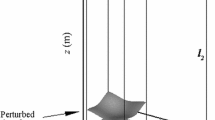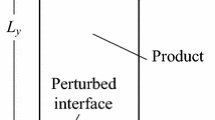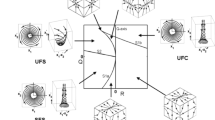Abstract
The three-dimensional interactions of a perturbed premixed flame interface with a planar incident shock wave and its reflected shock waves are numerically simulated by solving the compressible, reactive Navier–Stokes equations with the high-resolution scheme and a single-step chemical reaction. The effects of the initial incident shock wave strength (Mach number) and the initial perturbation pattern of interface on the interactions are investigated. The distinct properties of perturbation growth on the flame interface during the interactions are presented. Our results show that perturbation growth is mainly attributed to the flame stretching and propagation. The flame stretching is associated with the larger-scale vortical flow due to Richtmyer–Meshkov instability while the flame propagation is due to the chemical reaction. The mixing properties of unburned/burned gases on both sides of the flame are quantitatively analyzed by using integral and statistical diagnostics. The results show that the large-scale flow due to the vortical motion always plays a dominating role during the reactive interaction process; however, the effect of chemistry becomes more important at the later stage of the interactions, especially for higher Mach number cases. The scalar dissipation due to the molecular diffusion is always small in the present study and can be negligible.













Similar content being viewed by others
References
Marble, F.E., Sonneborn, G., Pun, C.S.J., et al.: Physic conditions in circumstellar gas surrounding SN 1987A 12 years after outburst. Astrophys. J. 545, 390–398 (2000). https://doi.org/10.1086/317809
Oran, E.S., Gamezo, V.N.: Origins of the deflagration-to-detonation transition in gas-phrase combustion. Combust. Flame 148, 4–47 (2007). https://doi.org/10.1016/j.combustflame.2006.07.010
Yang, J., Kubota, T., Zukoski, E.E.: Applications of shock-induced mixing to supersonic combustion. AIAA J. 31, 854–862 (1993). https://doi.org/10.2514/3.11696
Lindl, J.D., Mccrory, R.L., Campbell, E.M.: Progress toward ignition and burn propagation in inertial confinement fusion. Phys. Today 45, 32–40 (1992). https://doi.org/10.1063/1.881318
Ju, Y., Shimano, A., Inoue, O.: Vorticity generation and flame distortion induced by shock flame interaction. In: 27th Symposium (international) on combustion. The Combustion Institute, Pittsburgh, USA, pp 735–741 (1998). https://doi.org/10.1016/S0082-0784(98)80467-0
Khokhlov, A.M., Oran, E.S.: Numerical simulation of detonation initiation in a flame brush: the role of hot spots. Combust. Flame 119, 400–416 (1999). https://doi.org/10.1016/S0010-2180(99)00058-9
Thomas, G.O., Bambrey, R., Brown, C.: Experimental observations of flame acceleration and transition to detonation following shock–flame interaction. Combust. Theory Model. 5, 573–594 (2001). https://doi.org/10.1088/1364-7830/5/4/304
Gamezo, V.N., Oran, E.S., Khokhlov, A.M.: 3D reactive shock bifurcations. Proc. Combust. Inst. 30, 1841–1847 (2005). https://doi.org/10.1016/j.proci.2004.08.259
Dong, G., Fan, B.C., Ye, J.F.: Numerical investigation of ethylene flame bubble instability induced by shock waves. Shock Waves 17, 409–419 (2008). https://doi.org/10.1007/s00193-008-0124-3
Yuejin, Zhu, Gang, Dong, Yixin, Liu, et al.: 3D numerical simulations of spherical flame evolutions in reshock accelerated flows. Combust. Sci. Technol. 185, 415–1440 (2013). https://doi.org/10.1080/00102202.2013.798656
Markstein, G.H.: A shock-tube study of flame front-pressure wave interaction. In: 6th Symposium (international) on combustion. The Combustion Institute, Pittsburgh, USA, pp 387–398 (1957). https://doi.org/10.1016/S0082-0784(57)80054-X
Khokhlov, A.M., Oran, E.S., Chtchelkanova, A.Y.: Interaction of a shock with a sinusoidally perturbed flame. Combust. Flame 117, 99–116 (1999). https://doi.org/10.1016/S0010-2180(98)00090-X
Kilchyk, V., Nalim, R., Merkle, C.: Laminar premixed flame fuel consumption rate modulation by shocks and expansion waves. Combust. Flame 158, 1140–1148 (2011). https://doi.org/10.1016/j.combustflame.2010.10.026
Massa, L., Jha, P.: Linear analysis of the Richtmyer–Meshkov instability in shock-flame interactions. Phys. Fluids 24, 56–101 (2012). https://doi.org/10.1063/1.4719153
Jiang, H., Dong, G., Chen, X., et al.: Numerical simulations of the process of multiple shock-flame interactions. Acta Mech. Sin. 32, 659–669 (2016). https://doi.org/10.1007/s10409-015-0552-0
Jiang, H., Dong, G., Chen, X., et al.: A parameterization of the Richtmyer-Meshkov instability on a premixed flame interface induced by the successive passages of shock waves. Combust. Flame 169, 229–241 (2016). https://doi.org/10.1016/j.combustflame.2016.04.021
Chen, X., Dong, G., Jiang, H.: A 3D numerical study on instability of sinusoidal flame induced by multiple shock waves. Acta Mech. Sin. 33, 316–326 (2017). https://doi.org/10.1007/s10409-017-0639-x
Balsara, D.S., Shu, C.W.: Monotonicity preserving weighted essentially non-oscillatory schemes with increasingly high order of accuracy. J. Comput. Phys. 160, 405–452 (2000). https://doi.org/10.1006/jcph.2000.6443
Ukai, S., Balakrishnan, K., Menon, S.: Growth rate predictions of single- and multi-mode Richtmyer–Meshkov instability with reshock. Shock Waves 21, 533–546 (2011). https://doi.org/10.1007/s00193-011-0332-0
Nelson, N.J., Grinstein, F.F.: Effects of initial condition spectral content on shock-driven turbulent mixing. Phys. Rev. E 92, 013014 (2015). https://doi.org/10.1103/PhysRevE.92.013014
Liu, C.Q., Wang, Y.Q., Yang, Y., et al.: New omega vortex identification method. Sci. China Phys. Mech. Astron. 59, 684–711 (2016). https://doi.org/10.1007/s11433-016-0022-6
Latini, M., Schilling, O., Don, W.S.: Effects of WENO flux reconstruction order and spatial resolution on reshocked 2D Richtmyer–Meshkov instability. J. Comput. Phys. 221, 805–836 (2007). https://doi.org/10.1016/j.jcp.2006.06.051
Schilling, O., Latini, M.: High-order WENO simulations of 3D reshocked Richtmyer-Meshkov instability to late times: dynamics, dependence on initial conditions, and comparisons to experimental data. Acta Mathematica Scientia 30, 595–620 (2010). https://doi.org/10.1016/S0252-9602(10)60064-1
Poludnenko, A.Y., Oran, E.S.: The interaction of high-speed turbulence with flames: global properties and internal flame structure. Combust. Flame 157, 995–1011 (2011). https://doi.org/10.1016/j.combustflame.2010.09.002
Thornber, B., Drikakis, D., Youngs, D.L., et al.: Growth of a Richtmyer-Meshkov turbulent layer after reshock. Phys. Fluids 23, 95–107 (2011). https://doi.org/10.1063/1.3638616
Tritschler, V.K., Olson, B.J., Lele, S.K., et al.: On the Richtmyer–Meshkov instability evolving from a deterministic multimode planar interface. J. Fluid Mech. 755, 429–462 (2014). https://doi.org/10.1017/jfm.2014.436
Lombardini, M., Pullin, D.I., Meiron, D.I.: Turbulent mixing driven by spherical implosions. Part 2. Turbulence statistics. J. Fluid Mech. 748, 113–142 (2014). https://doi.org/10.1017/jfm.2014.163
Oggian, T., Drikakis, D., Youngs, D.L., et al.: Computing multi-mode shock-induced compressible turbulent mixing at late time. J. Fluid Mech. 779, 411–431 (2015). https://doi.org/10.1017/jfm.2015.392
Chen, X., Dong, G., Jiang, H., et al.: Numerical studies of sinusoidally premixed flame interface instability induced by multiple shock waves. Explos. Shock Waves 37, 229–236 (2017). https://doi.org/10.11883/1001-1455(2017)02-0229-08. (in Chinese)
Acknowledgements
The work was supported by the National Natural Science Foundation of China (11372140).
Author information
Authors and Affiliations
Corresponding author
Rights and permissions
About this article
Cite this article
Chen, X., Dong, G. & Li, B. Numerical study of three-dimensional developments of premixed flame induced by multiple shock waves. Acta Mech. Sin. 34, 1035–1047 (2018). https://doi.org/10.1007/s10409-018-0783-y
Received:
Revised:
Accepted:
Published:
Issue Date:
DOI: https://doi.org/10.1007/s10409-018-0783-y




